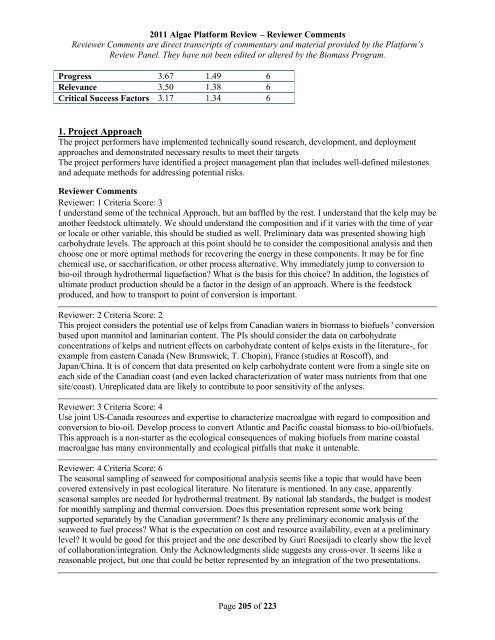Reviewer Comments - EERE
Reviewer Comments - EERE
Reviewer Comments - EERE
You also want an ePaper? Increase the reach of your titles
YUMPU automatically turns print PDFs into web optimized ePapers that Google loves.
2011 Algae Platform Review – <strong>Reviewer</strong> <strong>Comments</strong><br />
<strong>Reviewer</strong> <strong>Comments</strong> are direct transcripts of commentary and material provided by the Platform’s<br />
Review Panel. They have not been edited or altered by the Biomass Program.<br />
Progress 3.67 1.49 6<br />
Relevance 3.50 1.38 6<br />
Critical Success Factors 3.17 1.34 6<br />
1. Project Approach<br />
The project performers have implemented technically sound research, development, and deployment<br />
approaches and demonstrated necessary results to meet their targets<br />
The project performers have identified a project management plan that includes well-defined milestones<br />
and adequate methods for addressing potential risks.<br />
<strong>Reviewer</strong> <strong>Comments</strong><br />
<strong>Reviewer</strong>: 1 Criteria Score: 3<br />
I understand some of the technical Approach, but am baffled by the rest. I understand that the kelp may be<br />
another feedstock ultimately. We should understand the composition and if it varies with the time of year<br />
or locale or other variable, this should be studied as well. Preliminary data was presented showing high<br />
carbohydrate levels. The approach at this point should be to consider the compositional analysis and then<br />
choose one or more optimal methods for recovering the energy in these components. It may be for fine<br />
chemical use, or saccharification, or other process alternative. Why immediately jump to conversion to<br />
bio-oil through hydrothermal liquefaction? What is the basis for this choice? In addition, the logistics of<br />
ultimate product production should be a factor in the design of an approach. Where is the feedstock<br />
produced, and how to transport to point of conversion is important.<br />
<strong>Reviewer</strong>: 2 Criteria Score: 2<br />
This project considers the potential use of kelps from Canadian waters in biomass to biofuels ' conversion<br />
based upon mannitol and laminarian content. The PIs should consider the data on carbohydrate<br />
concentrations of kelps and nutrient effects on carbohydrate content of kelps exists in the literature-, for<br />
example from eastern Canada (New Brunswick, T. Chopin), France (studies at Roscoff), and<br />
Japan/China. It is of concern that data presented on kelp carbohydrate content were from a single site on<br />
each side of the Canadian coast (and even lacked characterization of water mass nutrients from that one<br />
site/coast). Unreplicated data are likely to contribute to poor sensitivity of the anlyses.<br />
<strong>Reviewer</strong>: 3 Criteria Score: 4<br />
Use joint US-Canada resources and expertise to characterize macroalgae with regard to composition and<br />
conversion to bio-oil. Develop process to convert Atlantic and Pacific coastal biomass to bio-oil/biofuels.<br />
This approach is a non-starter as the ecological consequences of making biofuels from marine coastal<br />
macroalgae has many environmentally and ecological pitfalls that make it untenable.<br />
<strong>Reviewer</strong>: 4 Criteria Score: 6<br />
The seasonal sampling of seaweed for compositional analysis seems like a topic that would have been<br />
covered extensively in past ecological literature. No literature is mentioned. In any case, apparently<br />
seasonal samples are needed for hydrothermal treatment. By national lab standards, the budget is modest<br />
for monthly sampling and thermal conversion. Does this presentation represent some work being<br />
supported separately by the Canadian government? Is there any preliminary economic analysis of the<br />
seaweed to fuel process? What is the expectation on cost and resource availability, even at a preliminary<br />
level? It would be good for this project and the one described by Guri Roesijadi to clearly show the level<br />
of collaboration/integration. Only the Acknowledgments slide suggests any cross-over. It seems like a<br />
reasonable project, but one that could be better represented by an integration of the two presentations.<br />
Page 205 of 223




